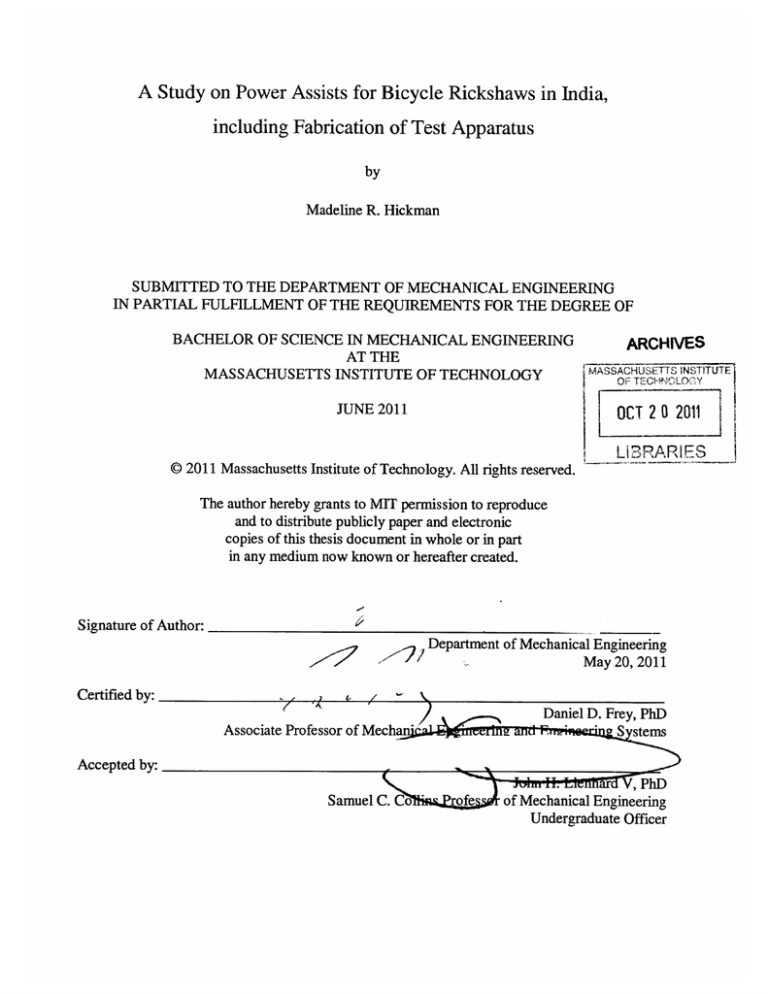
A Study on Power Assists for Bicycle Rickshaws in India,
including Fabrication of Test Apparatus
by
Madeline R. Hickman
SUBMITTED TO THE DEPARTMENT OF MECHANICAL ENGINEERING
IN PARTIAL FULFILLMENT OF THE REQUIREMENTS FOR THE DEGREE OF
BACHELOR OF SCIENCE IN MECHANICAL ENGINEERING
AT THE
MASSACHUSETTS INSTITUTE OF TECHNOLOGY
JUNE 2011
ARCHIVES
I
MASSCHUETTSINSITUTE
OF TEC1" NCLC>2'Y
OCT 2 2011
@ 2011 Massachusetts Institute of Technology. All rights reserved.
The author hereby grants to MIT permission to reproduce
and to distribute publicly paper and electronic
copies of this thesis document in whole or in part
in any medium now known or hereafter created.
Signature of Author:
Department of Mechanical Engineering
May 20, 2011
Certified by:.
~'
3
'-
/
Associate Professor of Mecha
e
Daniel D. Frey, PhD
Sstems
Accepted by:
Samuel C. C
oe
Dim~~~
!t;a ff
PhD
of Mechanical Engineering
Undergraduate Officer
2
A Study on Power Assists for Bicycle Rickshaws in India,
including Fabrication of Test Apparatus
by
Madeline R. Hickman
Submitted to the Department of Mechanical Engineering
on May 20, 2011 in Partial Fulfillment of the
Requirements for the Degree of Bachelor of Science in
Mechanical Engineering
ABSTRACT
Bicycle rickshaws impose significant physical burdens on their drivers. Used throughout India
for transportation, these rickshaws are not designed for driver comfort and safety. Instead,
traditional rickshaws are only single-speed, with an extremely high gear ratio that makes it
difficult for drivers to pedal with large loads. Particularly in India, many rickshaw drivers are
under-nourished, and the physical exertion required to pedal passengers over rough roads and
uneven terrain leads to serious health consequences. A power assist could go a long way
towards improving rickshaw comfort and ease of use for drivers by easing the burden on the
driver. Despite this, the cost and other constraints on modifications to the rickshaw severely
limit which solutions are feasible. This thesis explores a number of options for a gearing system
or power assist, and then documents the design and fabrication of a simple electric assist test
setup. Measurements and analysis from the test setup will help determine how much power is
needed to develop an effective assist, and which methods of assist can achieve that while staying
within the cost constraint and other constraints on the design.
Thesis Supervisor: Daniel D. Frey, PhD
Title: Associate Professor of Mechanical Engineering and Engineering Systems
co-Director, Singapore-MIT International Design Center
1
4
Acknowledgements
Many, many thanks to Gwyndaf Jones, who helped guide me through all stages of this project
from conception through fabrication. This project would definitely not have been possible
without his help and guidance!
Many thanks as well to Shane Colton, who helped me through the electrical side of the project,
from choosing and ordering parts, to wiring, and even to lending me his own motor controller
setup at the last minute. Again, this project would not have been possible without his help.
I would also like to thank Professor Frey, for taking the time to guide and supervise this thesis,
and for valuable suggestions on design ideas. Thanks to him and all of the above for their
patience!
And finally, I would like to thank D-Lab, Dennis Nagle, Ned Burnell, and Dhaval Adjodah, for
their contributions to this and the rickshaw project as a whole.
1
6
Contents
Acknowledgements..........................................................................................................................5
Chapter 1 Introduction........................................................................................................
9
1.1
Introduction to Bicycle Rickshaws ......................................................................................
9
1.2
Problems with Traditional Rickshaws..................................................................................
10
1.3
The Rickshaw Bank and M IT D-Lab..................................................................................
12
1.4
Overview of Thesis ................................................................................................................
14
Chapter 2 Drive System Designs............................................................................................16
2.1
Fixed Gear Ratio....................................................................................................................
16
2.2
Gearing System ......................................................................................................................
18
2.2.1 Two-Chain System .......................................................................................................
18
2.2.2 Retro-Direct .................................................................................................................
20
2.2.3 Derailleur.....................................................................................................................21
2.3
Power Assist ..........................................................................................................................
22
2.3.1 Electric Assist ..............................................................................................................
22
2.3.2 M echanical Assist ...................................................................................................
23
Chapter 3 Power Assist Overview .....................................................................................
25
3.1
Exis ting M odels .....................................................................................................................
25
3.2
Design Constraints .................................................................................................................
26
Chapter 4 Test Setup and Fabrication ..............................................................................
27
4.1
Rickshaw Fabrication.............................................................................................................27
4.2
Electrical Setup......................................................................................................................28
4.2.1 Motor...........................................................................................................................29
4.3
4.2.2 M otor Controller ..........................................................................................................
30
4.2.3 Batteries.......................................................................................................................
31
4.2.4 Data Collection ............................................................................................................
31
M echanical ............................................................................................................................
32
4.3.1 Drive Train Design.......................................................................................................32
4.3.2 Drive Train Fabrication...........................................................................................
33
4.3.3 Final Assembly ............................................................................................................
36
Chapter 5 Testing Plan ........................................................................................................
39
5.1
Preliminary Tests at M IT....................................................................................................
39
5.2
Testing in India ......................................................................................................................
39
5.3
Interpretation of Test Data..................................................................................................
40
Chapter 6 Conclusions ............................................................................................................
41
6.1
Summ ary ...............................................................................................................................
41
6.2
Next Steps..............................................................................................................................
41
Appendix A : Sprocket Design.................................................................................................
43
Appendix B: Rickshaw Drawings ............................................................................................
44
AppendixC: Motor Controller Wiring .......................................................................................
46
Bibliography .........................................................................................................
47
8
Chapter 1
Introduction
1.1
Introduction to Bicycle Rickshaws
Bicycle rickshaws are a widely used method of transportation throughout India.
The basic
rickshaw is a three-wheeled tricycle design, pedaled by a human driver in the front, and with a
bench seat in the rear for passengers or for conveying goods and luggage (Fig. 1-1).
As with a
taxi, passengers pay the rickshaw driver a fee to transport them from one place to another.
Fig. 1-1. Traditional Indian bicycle rickshaw (Photo credit: Gwyndaf Jones)
There are an estimated eight million cycle rickshaw pullers in India alone, with many more
in Bangladesh and other developing countries [1].
But bicycle rickshaws are growing in
popularity even in developed countries, with pedicab services springing up in major cities as a
novel, environmentally-friendly method of transportation for tourists and locals.
In India, however, rickshaws frequently serve as a means of employment for poor rural
citizens who have migrated to the cities looking for work. Without the training or skills needed
to get a desired job, those unable to find a better livelihood instead rent a rickshaw in an effort to
make a living. [2]
1.2
Problems with Traditional Rickshaws
Traditionally, rickshaw pullers do not own the rickshaws they drive. Most drivers are unable to
afford the initial cost of a rickshaw, and instead pay a daily rental fee to a rickshaw owner for use
of the vehicle. But high daily fees require drivers to spend the majority of their income on rent,
making it almost impossible to save enough money to ever own a rickshaw.' In addition to high
rent, drivers must also pay for accidental damages to the vehicle, making it difficult to earn
enough money just to provide for their families. Most drivers are unable to earn enough money
to lift themselves and their families out of extreme poverty, and instead continue to work long
hours in poor living conditions throughout the cities. [1]
1 Ninety-five percent of rickshaw
their own rickshaw. [2]
pullers in India are victims of high rental prices, making it impossible to afford
In addition to the economic problems caused by traditional rickshaw ownership, bicycle
rickshaws impose significant physical burdens on their drivers. Rickshaw drivers work long
hours, and many are under-nourished and living in extremely poor conditions. The strength and
endurance required to pedal passengers or goods over rough roads and uneven terrain take a huge
physical toll on the drivers, and the community sees frequent outbreaks of disease and other
health effects.
The mechanical design of traditional rickshaws does little to ease the burden on the
driver. Since drivers are not the ones purchasing the rickshaw, there is little incentive for sellers
to improve the design for better driver comfort and safety. Thus the traditional design is heavy
and inefficient, uncomfortable to ride and difficult to pedal. And there are a number of other
problems with the current design; rickshaws have poor braking and no nighttime safety lighting,
no suspension, and no gearing system. The existing gear ratio is very high 2 , making it difficult to
pedal uphill or start from a standstill, especially with the added weight of passengers and cargo.
The difficulty in pedaling takes a physical toll on the drivers, who frequently develop joint and
other injuries, or outbreaks of disease.
2The gear ratio on the Rickshaw Bank model (see Section 1.3) is nearly 2:1, with a 48-tooth sprocket
at the pedal
driving a 27 tooth sprocket on the rear axle.
1.3
The Rickshaw Bank and MIT D-Lab
In the Assam region of northeast India, an NGO called the Centre for Rural Development (CRD)
is attempting to change the economic model of rickshaw ownership. With a program called the
Rickshaw Bank, started in Guwahati by Dr. Pradip Sarmah, the CRD allows rickshaw drivers to
gradually gain ownership of their own rickshaw. Money from advertisements on the rickshaws
allows the program to loan a rickshaw to a driver, who pays a daily fee to the Rickshaw Bank in
return. Unlike the traditional daily rental fee, however, this money gradually pays for ownership
of the rickshaw.
In under eighteen months, drivers become full owners of their rickshaw,
allowing them to keep all future income and run their own micro-business.
The Rickshaw Bank was developed for the benefit of poor and often disregarded
rickshaw drivers, and as such has much more concern for their well-being than traditional
rickshaw owners.
The daily payments made by drivers also pay for insurance, training,
uniforms, and licenses, in addition to ownership of the vehicle.
And the Rickshaw Bank also
uses a non-traditional rickshaw design (Fig. 1-2). These rickshaws are manufactured locally, and
can be made in a workshop with welding capabilities. (Traditional rickshaws require both a
blacksmith and a carpenter).
Fig. 1-2. The Rickshaw Bank rickshaw (Photo credit: Gwyndaf Jones)
The Rickshaw Bank design has a number of improvements on the traditional rickshaw, with a
lighter, more aerodynamic frame, and safer seating. This design is easier for the driver to pedal
and more comfortable for passengers, giving it a big competitive advantage over other
rickshaws. The Rickshaw Bank hopes to use this advantage to propagate is economic model and
rickshaw design, and has a workshop in northeast India to manufacture vehicles with the
improved design.
While the Rickshaw Bank design is a significant improvement from the traditional
rickshaw, it still has a number of shortcomings in terms of comfort and safety. D-Lab, a program
at MIT focused on engineering for international development, has been working with the
Rickshaw Bank to develop further improvements to its design. Over the past several years, DLab students and faculty have designed a number of incremental changes to the existing
rickshaw model.
A redesigned frame replaces solid steel bar with tubing and steel angle,
significantly decreasing the weight of the rickshaw. The braking system has been significantly
improved with the addition of a rear foot brake, and a pedal-powered lighting system is in
development for safer night driving. There are also a number of ongoing projects focused on the
design and testing of possible gearing systems, to improve the current single-speed gear ratio of
the rickshaw.
1.4 Overview of Thesis
The lack of gearing system and high gear ratio on the current Rickshaw Bank model make
pedaling passengers incredibly difficult for rickshaw drivers. There are a number of potential
solutions to this problem, ranging from an improved gear ratio to a power assist to aid the driver.
This thesis presents a broad overview of existing and potential solutions, as well as the
design and fabrication of a simple test setup for an electric assist. Directors at the Rickshaw
Bank are particularly interested in the development of an electric assist, but there are a number of
functional requirements and design constraints that must be taken into account before this can be
a feasible solution. The test setup presented here is a simple electric assist, capable of testing
and recording varying levels of power to the motor and testing differing modes of assist. The
end goal of testing will be to determine power requirements for different levels of assist, by
testing the setup with rickshaw drivers in India and determining how much power is useful to
them for the added cost of the system. These results will allow the Rickshaw Bank to compare
the electric assist to other solutions, in terms of cost, added weight, complexity, and other
criteria.
Chapter 2 presents an overview of the various ways to improve on the current singlespeed rickshaw design, with various gearing and assist options.
Chapter 3 explores the power assist in greater detail, by looking at an electric cycle
rickshaw used briefly in Delhi. It describes some of the functional requirements and design
constraints of an electric assist system, and challenges of making such a system a feasible
solution.
Chapter 4 documents the design and fabrication of the test setup for this project.
Chapter 5 lays out a testing plan for bringing the test setup to India: what measurements
need to be taken and how, what conclusions will be drawn what calculations need to be
performed.
Chapter 6 summarizes the thesis, with plans and suggestions for future work.
Chapter 2
Drive System Designs
There are a number of potential solutions that would alleviate problems with the drive system on
the current rickshaw design. Several of these solutions are presented here, varying from simple
improvements to the gear ratio, to more complex power assist systems.
2.1
Fixed Gear Ratio
Perhaps the simplest improvement is a simple redesign of the gear ratio. The ratio on the current
Rickshaw Bank model is extremely high, with a 48-tooth sprocket at the pedal driving a 27 tooth
sprocket on the rear axle. Again, this makes pedaling difficult, especially with the added weight
of passengers and cargo.
Changing the number of teeth on one of the sprockets in the drive system could reduce
the gear ratio of the vehicle, making it much easier to pedal, and less physically taxing on the
driver. This was tested by waterjetting a series of sprockets, each with an additional two teeth
for determining the optimal gear ratio. As with the current sprocket, these were made to be
bolted to a freewheel on the rear axle.3
(See Appendix A for details of sprocket design.) These
sprockets were brought to India, and initial testing with them showed improved results in driver
comfort and ease of pedaling with some changes in the gear ratio.
Fig. 2-1. Waterjet sprockets were mounted on freewheels for testing at the Rickshaw Bank.
3A
freewheel is a sprocket with an internal ratcheting mechanism, which allows it to spin around a
threaded body. Turning the sprocket in one direction allows it to spin freely around the center, while
turning it in the other direction causes the internal mechanism to catch and spin the entire freewheelthreaded body and sprocket-together. The entire freewheel threads onto a bicycle hub, allowing the
wheel and hub to spin even if the driver is not pedaling and driving the freewheel forward.
While this solution is simple and seemingly beneficial, it is still not a complete solution to the
current gearing problem. The optimal gear ratio for coasting or driving without passengers will
be drastically different than that required for driving uphill or with heavy loads, and this solution
still does not allow for changes between gears. Whatever gear ratio is chosen will not be the best
one for all scenarios, and drivers will continue to undergo extreme physical exertion or
efficiency losses in certain situations.
2.2
Gearing System
A system that allows the driver to switch between gears would improve the situation yet further,
by allowing the driver to choose a gear ratio appropriate to the situation (low gear for starting
from a standstill and travelling up an incline, high gear when pedaling at speed).
There are
several methods of gearing that have been developed for rickshaws, as well as those currently
available for bicycles.
2.2.1 Two-Chain System
One such system, developed by students in D-Lab and prototyped in India the Rickshaw Bank
workshop, uses a pair of chains to create a two-speed system. Each chain has a different gear
ratio, one mounted on either side of the pedal crank to separate sprockets in the rear. The driver
can change which rear sprocket is engaged, allowing him to switch between high and low gear
(Fig. 2-2).
(a)
Fig. 2-2. (a) Two-chain gearing system developed by students in MIT D-Lab. (b) Close-up of
shifting mechanism. (Photo credits: Gwyndaf Jones).
This solution is relatively straightforward, although clunky and requires a bit more design of the
shifting mechanism.
2.2.2 Retro-Direct
A more compact two-speed drive system is the retro-direct, developed for bicycles in the early
1900s. This system allows the driver to pedal forward for a low gear, and backwards for a high
gear, while constantly driving the rickshaw forward (Fig 2-3). The setup works by mounting two
rear sprockets of different sizes on opposing freewheels, such that pedaling forward engages the
larger of the two, and pedaling backwards engages the smaller.
Rear Wheel
Okectios, of chauin dining
forard peda w+ch
engage Warg
"eM sprocket
Pedal
Sprocket
Free wheel
sprocket
Fig. 2-3. Retro-direct gearing system. Both rear sprockets are mounted on freewheels, such that
pedaling forward engages the large rear sprocket for a low gear, and pedaling backwards engages
the small rear sprocket for a higher gear.
This system is a relatively simple and seemingly effective solution, but the current design
prevents the rickshaw from rolling backwards due to the opposing freewheels. Being able to
push the rickshaw backwards is a necessity for drivers, who have to back out of parking spaces,
as well as out of traffic jams in bumper-to-bumper Indian traffic.
A method of disengaging the drive system, or some other way to allow the retro-direct
rickshaw to roll backwards, would make this a much more feasible solution. A team at Olin
College is currently in the development stage of a potential design.
2.2.3 Derailleur
The designs mentioned previously are all two speeds or less. But there are a number of shifting
mechanisms designed for bicycles that allow for many more speeds and still only require a single
chain. Derailleurs are used on most modem bicycles, and are simpler than many of the other
bicycle gearing systems. The derailleur mechanism, shown in figure 2-4, uses an arm to tension
the chain and pull it between sprockets in order to shift gears.
Fig. 2-4. Derailleur shifting mechanism on a modem bicycle (Photo credit:
http://tinyurl.com/derailleur-source)
Despite the widespread use of derailleurs in many parts of the world, however, research in India
has shown a huge cultural stigma preventing their use. Whether for reliability concerns or other
reasons, Indian rickshaw drivers will be unlikely to adopt a derailleur system or anything that
looks like a traditional derailleur. So unless a similar system can be developed in an enclosed
case or with a more robust design, or with some other significant change, it will be difficult to
get drivers to accept and adopt the design.
2.3
Power Assist
A third option for solving the gearing problem is to add some method of power assist, which
would provide additional power to the rickshaw to supplement that provided by the driver. This
additional energy could be stored in batteries and transmitted through a motor, or stored through
some sort of mechanical storage method.
This would be particularly useful in situations
requiring high torque, such as starting the rickshaw from a standstill or pedaling passengers up a
hill. In addition to easing the physical burden on the driver, a powered system could also make
the cycle rickshaws competitive with less environmentally-friendly modes of transportation like
cars and auto rickshaws.
2.3.1 Electric Assist
An electric assist requires the addition of an electric motor to a modified rickshaw frame, as well
as energy storage in rechargeable batteries. Other necessary components include a throttle and
controller of some sort, in order to incrementally change the motor output (depending the method
of assist), as well as a method of charging the batteries.
While a working electric assist could be extremely beneficial to drivers, there are a
number of constraints which limit design and feasibility. Cost of the system, for instance, could
easily become prohibitively expensive for drivers in India, and the monsoons mean that any
system would have to be very robust and weatherproof.
In addition, ability to do local
manufacture and repair is an important consideration when beginning to outsource parts like
batteries and motor systems. While electric assist systems have been developed, there are many
questions and tests that need to be done in order to determine if this solution is a feasible one for
drivers at the Rickshaw Bank. The idea of the electric assist, including existing models and key
questions, is explored more in Chapter 3.
2.3.2 Mechanical Assist
A power assist system could also be accomplished with some form of mechanical energy
storage. Potential energy storage mechanisms include a flywheel, compressed air, and a spring.
There are a number of different forms that this system could take. A strong spring, for instance,
could capture energy while the rickshaw coasts down hills, or store energy while stopping the
rickshaw (akin to a regenerative brake), and release it later to give the driver a boost when
starting up again.
With compressed air, a tank of compressed air could power pistons or a
compressed air engine in order to assist the driver. In both cases, however, there are a number of
challenges with energy capacity and efficiency of the mechanical storage; the energy captured in
a spring from coming to a stop would not be enough to start the rickshaw up again, due to
numerous losses in the system. As with any system, exposure to weather could have a serious
effect on a mechanical system.
Despite its challenges, a mechanical system would alleviate a number of the problems
with a purely electric assist. Batteries are particularly expensive, and inexpensive batteries often
last for only a few years. The high cost of the system, plus the added costs of occasional battery
replacements, could make the system too expensive for the rickshaw community to afford. And
while a simple mechanical assist could be a better solution, the amount of power needed for a
useful electric assist could be difficult to achieve with mechanical energy storage.
Chapter 3
Power Assist Overview
3.1
Existing Models
There are several existing designs for electric-assist bicycle rickshaws.
A company in the
Boston area, Metro Pedal Power, runs a delivery service with electric-assist cycle rickshaws.
These vehicles have very effective electric assists, which operates as long as the driver is
pedaling, but were imported from England and would be prohibitively expensive for any drivers
in the developing world (on the order of $10k).
Another existing model, the Soleckshaw, was designed for use in India by the Centre for
Scientific and Industrial Research. Prototypes have been deployed in Delhi, including a method
of recharging batteries in which empty batteries are swapped out for fully charged cells at solar
recharging stations.
The Soleckshaw design faces several big challenges, however.
The
prototypes are prohibitively expensive, especially for relatively poor rickshaw drivers who
cannot afford the traditional rickshaw at almost a third of the price. Charging stations are
expensive to set up, and batteries only last for 6-8 hours before needing a full day of charge. The
cost of maintaining the rickshaw and paying for continual battery charges may make any benefit
to the Soleckshaw negligible. In addition, the electric motor has difficulty withstanding the start-
stop traffic in Delhi's busy streets. Though introduced in Delhi, the Soleckshaw has not been
widely adopted there or elsewhere. [3]
3.2
Design Constraints
As is evident from the Soleckshaw example, there are a number of design constraints that must
be met to make a power assist or any system feasible in India. Perhaps most important is cost;
rickshaw drivers already have difficulty paying off a bicycle rickshaw, so paying off the added
cost of an electric assist or other add-on may not be worth the added cost. In addition, an electric
assist has a number of additional costs, including battery charging and maintenance, which
would require pullers to raise their fees and possibly lose business.
A system with heavy batteries or a flywheel may have enough added weight that the
benefit of using the assist is offset by the continuous added weight of the system. Different
modes of assist may be less heavy and less expensive, but may not produce enough power to be
worthwhile.
In order to determine the feasibility of a power assist of any kind, then, it is
necessary to determine how much power is required to create a useful, noticeable assist for
which drivers would be willing to pay increased costs.
Chapter 4
Test Setup and Fabrication
The test setup presented in this chapter was designed and built to help answer questions about
power requirements, and to do testing with a simple electric assist setup. This chapter will walk
through the design and fabrication of its components.
4.1
Rickshaw Fabrication
In order to develop an assist, a rickshaw first had to be built. The design used for the rickshaw
frame is a modification of the Rickshaw Bank model developed at D-Lab (see Appendix B for
mechanical drawings). This design is more lightweight than the previous model, and is welded
together from steel angle and tubing (Fig. 4-1). Some of the stock rickshaw components were
brought back from India, but the fabrication of the frame, welding, spoking of wheels, and other
assembly tasks were completed at D-Lab.
Fig. 4-1. Completed rickshaw frame at D-Lab, MIT.
The front brake and bicycle frame attachment are constructed as per the current Rickshaw Bank
design.
4.2
Electrical Setup
The electric system of the assist is relatively simple, consisting of batteries, motor, motor
controller, and a Watt meter and power analyzer for taking power measurements.
setup is as follows:
The basic
12V
12V
Fig. 4-2. Electrical setup of the electric assist.
The components are detailed below, with more detailed wiring diagrams for the motor controller
in the appendix.
4.2.1 Motor
The motor was chosen for its power rating and cost. Regulations in India restrict electric bikes
for unlicensed drivers to 250 watts of power output 4, so a 350-watt motor was chosen in order to
test how this restriction affects the ideal electric assist power for a rickshaw. (This will allow
testing to see if the amount of power needed to make a useful assist is actually above the legal
regulations.)
The motor used in the current setup was ordered from All Electronics (Model XYD-6D),
and is a 350-watt motor made for Currie Technologies Inc. electric scooters. The motor runs on
24volts DC, with a rated speed of 2600 rpm and a rated current of 22 amps.
4
Source: http://www.electricbikee.com/qlobal-electric-bike-laws/
Fig. 4-3. Motor, with sprocket welded on collar on the shaft for the chain drive.
The cost of the motor was low ($24), keeping the system within the scope of the project budget.
4.2.2 Motor Controller
The motor controller used in the test setup was produced by Kelly Controls, and is a small KDS
Series/PM Brushed DC Motor Speed Controller (part number: KDS36200). The controller is
designed for battery voltages of 24 to 36 volts, reprogrammable on a computer with software
downloaded from the Kelly Control website. The motor controller itself is wired to a throttle and
switch, as shown in the wiring diagrams in the appendices.
In future iterations of the test setup, it may be beneficial to order a different Kelly
Controller with regenerative braking capability, if that is a desired feature of a final system.
4.2.3 Batteries
Two 12-volt batteries were wired in series to reach the 24 volts required by the motor. The
batteries were chosen for availability, so many more considerations would have to be considered
before choosing batteries for an electric assist in India (cost, local availability, robustness, energy
density, etc.). The chosen batteries are non-spillable lead acid batteries made by Zeus, with a 17
amp-hour capacity per battery (part number: PC17-12NB). These batteries are rechargeable, and
can be charged from a wall outlet with a 12-volt, 5-amp-hour charger also made by Zeus.
4.2.4 Data Collection
With the current setup, data collection is done by a Turnigy Precision Watt Meter and Power
Analyzer, rated to 130 amps. Wired in line between the batteries and motor controller, the watt
meter measures current into the motor, voltage across the batteries, the peak and average power
drawn by the motor, and the total energy and charge delivered to the motor while the watt meter
is running. In particular, this is useful in determining how much power is required for a useful
power assist, and in what situations (used when starting, when driving uphill, or continuously).
Additional data collection tools are being developed by students at D-Lab to determine
the force that the rickshaw driver uses to pedal the rickshaw, as well as the rate of pedaling. A
tachometer and current measurement at the motor (with shunts) would also all measurement of
the power outputted by the motor into the drive system.
4.3
Mechanical
In order to integrate the electrical system with the rickshaw to assist the driver, there were a
number of modifications that had to be made to the rickshaw frame.
4.3.1 Drive Train Design
In order to provide enough torque to assist the driver, the output from the motor must be geared
down significantly to reach high torque at the rear axle. The necessary gear ratio was calculated
from the rated speed of the motor and the pedaling speed of a rickshaw driver. From research
done in India, a reasonable pedaling rate for a driver is 30 rpm. With the gearing ratio of 48:27
from the pedal to the rear axle, the rear axle should turn at around 54 rpm. To achieve the same
speed at the rear axle with the motor drive, the motor output must be geared down from its rated
speed of 2600 rpm to 54 rpm, for a gear reduction of 1:48.
The implication of this setup is that, when a driver is pedaling at low speeds as he would
when starting from a standstill or attempting to pedal uphill, the motor will drive the rear axle
faster than his pedaling speed, and the electric assist will take effect. When the driver is pedaling
faster than this, when cruising or pedaling down an incline, the driver will be pedaling faster and
the motor ideally would see no load.
4.3.2 Drive Train Fabrication
In order to maintain reasonable sprocket sizes and fit the drive train within the space constraints
of the rickshaw frame, the necessary gear reduction from the motor was accomplished in three
stages: a 16:48 reduction from the motor to the first axle, a 12:48 reduction from the first axle to
the second axle, and a 12:48 reduction again from the second axle to the rear axle. This results
in an overall gear ratio of 1:48, as desired.
48
12
~16
12
48
Rear axle
Fig.4-4. Gear train design.
To fabricate the gear train, custom sprockets were waterjet and attached to bicycle hubs (see
Appendix A for design). Bicycle hubs, used in bicycle wheels, consist of a hub which spins
freely on bearings around an axle.
The 48-tooth sprockets were bolted to freewheels and
screwed onto the threaded end of each hub, with a second lock-nut on the first shaft to keep the
freewheel from unthreading during use (the force on the second axle causes the freewheel to
tighten instead of loosen, rendering this unnecessary).
(b)
Fig.4-5. (a) Waterjet sprockets for the motor drive train, and (b) a 48-tooth sprocket mounted on
a freewheel.
To mount the small, 12-tooth sprockets, the hubs were pulled apart and sprockets slid onto the
center, welded to spacers turned down from steel tube. Facing the spacers on a lathe ensured that
the sprockets were mounted straight on the hubs, and were at the correct distance from each
other. The hubs were then pressed back together and repacked with ball bearings and grease.
Fig. 4-6. Sprockets mounted on bicycle hub to gear down motor output.
The 16-tooth sprocket on the motor was welded to a collar and pinned to the motor shaft (see
Fig. 4-3 above).
4.3.3 Final Assembly
Finally, the drive train and motor were assembled and mounted within the frame of the rickshaw,
within narrow space constraints. Slotted mounts for the motor and each axle allow the chains to
be tensioned sequentially, from the rear axle all the way to the motor. Angle iron and steel
flatstock welded to the frame provide the mounting system and support for the drive train, which
is particularly stiff between the two hub axles to prevent them from pulling together.
Fig. 4-7. Drive system during assembly.
Fig. 4-8. Slotted motor mount.
Fig. 4-9. Completed drive train assembly.
The electric system was wired to the mounted motor, and the batteries and motor controller sit on
the deck of the rickshaw for testing. Additional weight must be added to the rear deck during
testing in order to simulate the load from cargo and passengers.
Fig. 4-10. Completed test setup and electric assist.
Chapter 5
Testing Plan
5.1
Preliminary Tests at MIT
Before bringing the setup to India, some initial work will be done at MIT to test the system and
make sure the apparatus functions reliably over time. The current apparatus will be useful in
determining how much power is required to make a useful assist, and whether it is possible to
meet that requirement given the cost and material constraints in India, as well as the regulations
on electric power in Delhi and other cities.
The electric assist apparatus can be integrated with the measurement setup currently in
development at D-Lab, which will measure the force exerted by the driver. This will allow
testers to track how much a given level of electric assist reduces the force that the driver must
exert in various situations, particularly when starting and stopping with heavy loads or driving
uphill.
5.2
Testing in India
Since the final goal of the project is a determination of whether an assist is feasible for drivers in
India, most of the final testing will be performed there. In testing, a regular rickshaw driver will
be asked to drive at normal speeds for a given length of time, with and without varying power
levels of assist. The test apparatus can also test different modes of assist, such as an assist that
only helps at low speeds when starting or driving uphill, or one that is completely user-initiated
and controlled.
5.3
Interpretation of Test Data
Once data has been collected on the benefits of various levels of power assist, testers will have to
work with rickshaw pullers and the Rickshaw Bank to compare the added weight and cost
needed to achieve that level of power for each of several systems (electric assist, compressed air,
etc.). If drivers are unwilling or unable to pay the cost needed for a system to reach useful levels
of power, or if low energy density of a system makes it impossible to achieve the required power
given space and weight constraints, then that system is not a feasible method of producing a
power assist.
The efficiency of the rickshaw will be determined from the test apparatus by measuring
the power drawn from the battery to achieve a certain speed of the rickshaw. This will help
characterize the system, which will be useful when evaluating other methods of assist.
The results of the power assist analysis can be compared against testing currently being
done on a number of gearing systems, to come up with a conclusion on the most feasible method
for improving on the current single-speed rickshaw design.
Chapter 6
Conclusions
6.1
Summary
A power assist could go a long way towards improving rickshaw comfort and ease of use for
drivers, decreasing outbreaks of disease among those not eating enough to withstand the physical
exertion of pedaling a rickshaw each day. The assist would also open up steeper routes to
bicycle rickshaws, making the entire system more viable as an alternative transportation method
to cars. Despite these benefits, there are a number of constraints which may prevent a power
assist from becoming a feasible solution. The test apparatus presented in this thesis has been
designed and fabricated to answer questions about the level of power required for a useful assist,
such that the feasibility of different solutions can be compared. With testing at MIT and in India,
this setup should give an estimate of the most feasible and cost-effective solution to the current
problems surrounding single-speed rickshaws, in India or elsewhere.
6.2
Next Steps
In addition to completing the testing procedures described above, a few more steps can be taken
to further this project. Before the system is brought to India for testing, the electronics should be
enclosed in a weatherproof container to protect against rain and dust. The electronics themselves
are also relatively simple at the moment, and could benefit from a more robust design. Finally,
the results of testing should give an indication of where to take the project in the future, whether
that is an electric assist, mechanical assist, or simple gearing system.
Appendix A: Sprocket Design
Sprockets were constructed in Solidworks, as per the method presented in reference [4]. A
single tooth can be drawn in a sketch, defined by the number of teeth in the entire sprocket and
the specifications of the chain. The MathCAD file below (Fig. A-1) determines the outer
diameter of the sprocket, and the tooth can be copied at that distance about a center to produce
the full sprocket. (See [4] for more details.) Once waterjet, sprocket teeth were filed down on
each side to better guide the chain.
Chain specifications
Dr :0312in
DS =3 2in
P := 0.5in
Number of sprocket teeth
Nteeth := 48
F-D-
H:= IF-
.-co 18deg -
k,.
+ 1.4-cos 17
Nteeth
deg
-
-
1.325
-
.0015in
1dteeth
(1.4-Dr - 0.5-P)2
K
-(Ds - D,) + 2-H
OD := P-co 1S0deg) + Cos
Nteeth)
OD = 7.974-in
Nteeth
Outer Diameter
Fig. A-1. MathCAD document for determining sprocket diameter.
Appendix B: Rickshaw Drawings
The following drawings, developed by Dhaval Adjodah and Gwyndaf Jones, describe the
rickshaw frame built as a test platform for this project.
TOP VIEW
MWX
Iiso oft!I6 fVor
Fig. B-1. Rickshaw frame drawings
Appendix C: Motor Controller Wiring
I
)I
04 it
43
06
a
rR
0
Fig. C-1. Wiring diagram for the KDS36200 controller from the Kelly KDS User Manual,
available online. The wiring used in the test setup does not include the contactor circuits, instead
connecting the motor directly to the controller.
Bibliography
[1] Pradip Kumar Sarmah. 2010. "Rickshaw Bank: Empowering the Poor through Asset
Ownership." Innovations, Volume 5 Issue 1. p. 35-55.
http://www.mitpressjournals.org/doi/pdf/10.1162/itgg.2010.5.1.35
[2] Centre for Rural Development. 2008. 'The Rickshaw Bank." http://www.crdev.org/rb.asp
[3] Sriram Vadlamani. 2010. "Soleckshaw - Solar rickshaw as green postal delivery vehicle!"
Asian Correspondent.http://asiancorrespondent.com/37308/soleckshaw-%E2/o80%93-solarrickshaw-as-green-postal-delivery-vehicle/
[4] W. E. Johns. 2003. Notes on Sprockets and Chains. The Gizmologist's Lair.
http://www.gizmology.net/sprockets.htm.








